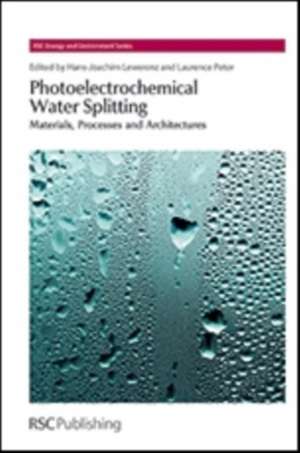Photoelectrochemical Water Splitting: RSC Energy and Environment, cartea 09
Ferdi Schuth, Tim S. Zhao, Heinz Frei Editat de Hans-Joachim Lewerenz, Laurie Peteren Limba Engleză Hardback – 3 oct 2013
A volume that will provide a comprehensive overview of current activity in the field of photoelectrochemistry that is contributing increasingly to the development of novel strategies, materials and processes that can be used for the production of solar fuels. Topics covered will include: aspects of photoelectrochemical water splitting; combinatorial approach to materials discovery for water splitting; mesoporous transition metal oxides for water splitting; tandem photoelectrochemical cells for water splitting; nano-architectures for solar water splitting devices; microheterogeneous photocatalysts for water splitting; efficient III-V architectures for H2O splitting; the III-V nitride family; coupled electron proton transfer; computational insights into O2-evolving complex of PSII; hydrogen evolution; surface analysis of molecular adsorbates on oxides; interfacial kinetics; surface analysis of catalysts and absorbers; biomimetic systems and catalysts; multi-electron transfer; molecular catalysts for solar fuels; third generation devices; plasmonics; energy transfer; and future development horizons.
Din seria RSC Energy and Environment
- 9%
 Preț: 1109.54 lei
Preț: 1109.54 lei - 14%
 Preț: 1388.15 lei
Preț: 1388.15 lei - 14%
 Preț: 1239.89 lei
Preț: 1239.89 lei - 14%
 Preț: 1196.52 lei
Preț: 1196.52 lei - 14%
 Preț: 1134.91 lei
Preț: 1134.91 lei - 14%
 Preț: 1247.66 lei
Preț: 1247.66 lei - 14%
 Preț: 1370.21 lei
Preț: 1370.21 lei - 14%
 Preț: 1352.51 lei
Preț: 1352.51 lei - 14%
 Preț: 951.22 lei
Preț: 951.22 lei - 14%
 Preț: 975.38 lei
Preț: 975.38 lei - 14%
 Preț: 1089.52 lei
Preț: 1089.52 lei - 14%
 Preț: 1384.87 lei
Preț: 1384.87 lei - 9%
 Preț: 970.24 lei
Preț: 970.24 lei - 9%
 Preț: 1066.24 lei
Preț: 1066.24 lei - 9%
 Preț: 1172.49 lei
Preț: 1172.49 lei - 9%
 Preț: 1100.42 lei
Preț: 1100.42 lei
Preț: 973.26 lei
Preț vechi: 1069.51 lei
-9% Nou
Puncte Express: 1460
Preț estimativ în valută:
186.29€ • 202.42$ • 156.59£
186.29€ • 202.42$ • 156.59£
Carte indisponibilă temporar
Doresc să fiu notificat când acest titlu va fi disponibil:
Se trimite...
Preluare comenzi: 021 569.72.76
Specificații
ISBN-13: 9781849736473
ISBN-10: 1849736472
Pagini: 468
Ilustrații: illustrations
Dimensiuni: 165 x 236 x 32 mm
Greutate: 0.88 kg
Editura: Royal Society Of Chemistry
Seriile RSC Energy and Environment Series, RSC Energy and Environment
ISBN-10: 1849736472
Pagini: 468
Ilustrații: illustrations
Dimensiuni: 165 x 236 x 32 mm
Greutate: 0.88 kg
Editura: Royal Society Of Chemistry
Seriile RSC Energy and Environment Series, RSC Energy and Environment
Cuprins
1 The Potential Contribution of Photoelectrochemistry in the Global Energy Future; 2 Kinetics and Mechanisms of Light-Driven Reactions at Semiconductor Electrodes: Principles and Techniques; 3: Structured Materuals for Photoelectrochemical Water Splitting; 4: Tandem Photoelectrochemical Cells for Water Splitting; 5: Particulate Oxynitrides for Photocatalytic Water Splitting under Visible Light; 6: Rapid Screening Methods in the Discovery and Investigation of New Photocatalyst Compositions; 7: Oxygen Evolution and Reduction Catalysts: Structural and Electronic Aspects of Transition Metal Based Compounds and Composites; 8: The Group II-Nitride Materials Class: from Preparation to Perspectives in Photoelectrocatalysis; 9: Epitaxial III-V Thin Film Absorbers: Preparation, Efficient InP Photocathodes and Routes to High Efficiency Tandem Structures; 10: Photoelectrochemical Water Splitting: A First Principles Approach; 11: Electro- and Photocatalytic Reduction of CO2: The Homogeneous and Hetereogeneous Worlds Collide?; 12: Key Intermediates in the Hydrogenation and Electrochemical Reduction of CO2; 13: Novel Approaches to Water Splitting by Solar Photons; 14: Light Harvesting Strategies Inspired by Nature; 15: Electronic Structure and Bonding of Water at Surfaces; 16: New Perspectives and a Review of Progress
Textul de pe ultima copertă
There has been a resurgence of interest in light-induced water splitting as the search for storable carbon neutral energy becomes more urgent. Although the history of the basic idea dates back more than four decades, efficient, economical and stable integrated devices have yet to be realized. In the continuing quest for such devices, the field of photoelectrochemistry is entering a new phase where the extraordinary interdisciplinary of the research and development efforts are opening new avenues. This aspect of current research effort is reflected in the chapters of this book, which encompass present thinking in the various disciplines such as materials science, photo-electrochemistry and interfaces that can contribute to realization of viable solar fuel generators. This book presents a blend of the background science and recent advances in the field of photoelectrochemical water splitting, and includes aspects that point towards medium to long term future realization. The content of the book goes beyond the more traditional approaches to the subject by including topics such as novel excitation energy processes that have only been realized so far in advanced photonics. The comprehensive overview of current activities and development horizons provided by the impressive collection of internationally renowned authors therefore represents a unique reflection of current thinking regarding water splitting by light.
